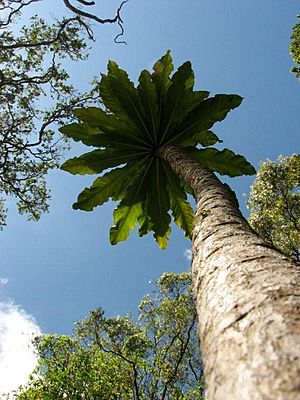Superb cyanea facts for kids
Quick facts for kids Superb cyanea |
|
|---|---|
 |
|
| Conservation status | |
| Scientific classification | |
| Genus: |
Cyanea
|
| Species: |
superba
|
Cyanea superba is a very rare flowering plant. It belongs to the bellflower family. People often call it the Mt. Kaala cyanea or superb cyanea. This plant is special because it only grew naturally on the island of Oahu in Hawaii. Sadly, it is now extinct in the wild, meaning it no longer grows on its own in nature.
However, scientists and plant experts are working hard to grow it in special gardens and facilities. Some of these plants have even been put back into protected areas where they can hopefully grow again. The United States government lists Cyanea superba as an endangered species. In the Hawaiian language, this plant, like other Cyanea species, is known as haha.
Contents
Where It Lived
This Hawaiian plant, called a Hawaiian lobelioid, used to grow in the lowland forests of Oahu. It was found in two mountain ranges: the Waianae Mountains and the Koʻolau Mountains.
Two Types of Cyanea superba
There were once two different types, or subspecies, of Cyanea superba.
- The first type, called ssp. regina, has not been seen since 1932. Scientists believe it is now completely extinct.
- The second type, ssp. superba, was first found and collected in the 1800s. After that, it disappeared for a long time. It was finally found again in 1971.
Its Disappearance
In the 1970s, about 60 ssp. superba plants were counted. But their numbers quickly dropped. By 1991, when the plant was officially listed as endangered, only 20 plants were left. These last few plants slowly died off, and the very last one in the wild died in 2002.
Helping Cyanea superba Survive
Even though it's gone from the wild, people are working hard to bring Cyanea superba back.
Growing New Plants
Many places in Hawaii are growing this plant from seeds or cuttings. This process is called plant propagation. These new plants are then carefully placed in different parts of Oahu. Often, these areas are fenced to protect the plants from harm.
Success Stories
Many of the planted Cyanea superba have done well. They have grown, produced flowers, and even made healthy seeds. Young plants, called seedlings, have also been seen growing from these seeds. The U. S. Army has collected more than 50,000 seeds from these plants. They are keeping these seeds safe in storage, just in case they are needed in the future.
Why It Became Extinct in the Wild
Several things caused Cyanea superba to disappear from its natural home.
Habitat Loss and Damage
One of the biggest problems was the destruction of its habitat. This means the places where it lived were damaged or destroyed. Wild animals like feral pigs and rats caused a lot of harm. Also, new species of slugs, brought to Hawaii by people, damaged the plants.
Competition from Other Plants
Cyanea superba also faced tough competition from invasive plant species. These are plants that are not native to Hawaii but grow very quickly and take over. Some of these harmful plants include:
- Kukui (Aleurites moluccanus)
- Silk oak (Grevillea robusta)
- Christmas berry (Schinus terebinthifolius)
Ongoing Threats
Even the plants that have been put back into protected areas still face dangers. These include fires, which can start during military exercises or from arson (when someone purposely starts a fire).
See also
 In Spanish: Cyanea superba para niños
In Spanish: Cyanea superba para niños


